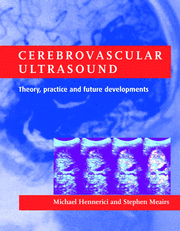Book contents
- Frontmatter
- Dedication
- Contents
- List of contributors
- Preface
- PART I ULTRASOUND PHYSICS, TECHNOLOGY AND HEMODYNAMICS
- PART II CLINICAL CEREBROVASCULAR ULTRASOUND
- (i) Atherosclerosis: pathogenesis, early assessment and follow-up with ultrasound
- 8 Morphogenesis of the atherosclerotic plaque
- 9 Hemodynamics and atherosclerosis
- 10 Carotid artery intima-media thickness
- 11 Non-invasive evaluation of endothelial function with B-mode ultrasound imaging of flow-induced brachial artery reactivity
- 12 Plaque characterization and risk profiles
- 13 Natural history of asymptotic carotid stenosis
- (ii) Extracranial cerebrovascular applications
- (iii) Intracranial cerebrovascular applications
- PART III NEW AND FUTURE DEVELOPMENTS
- Index
8 - Morphogenesis of the atherosclerotic plaque
from (i) - Atherosclerosis: pathogenesis, early assessment and follow-up with ultrasound
Published online by Cambridge University Press: 05 July 2014
- Frontmatter
- Dedication
- Contents
- List of contributors
- Preface
- PART I ULTRASOUND PHYSICS, TECHNOLOGY AND HEMODYNAMICS
- PART II CLINICAL CEREBROVASCULAR ULTRASOUND
- (i) Atherosclerosis: pathogenesis, early assessment and follow-up with ultrasound
- 8 Morphogenesis of the atherosclerotic plaque
- 9 Hemodynamics and atherosclerosis
- 10 Carotid artery intima-media thickness
- 11 Non-invasive evaluation of endothelial function with B-mode ultrasound imaging of flow-induced brachial artery reactivity
- 12 Plaque characterization and risk profiles
- 13 Natural history of asymptotic carotid stenosis
- (ii) Extracranial cerebrovascular applications
- (iii) Intracranial cerebrovascular applications
- PART III NEW AND FUTURE DEVELOPMENTS
- Index
Summary
Introduction
Atherosclerosis is a chronic multifocal disease of the major arteries characterized by the formation of arterial intimal plaques. The lesions consist of accumulations in the intima of intracellular and extracellular lipids, cells and associated matrix fibres, as well as regions of necrosis including tissue debris and lipid in various physical states. These components tend to be stratified and organized, often in a manner which suggests both healing and recrudescent reactions. The initiating event or events which induce the early plaques are not entirely clarified but the entry and accumulation of cells and of lipids in the form of altered lipoproteins together with other plasma proteins in relation to altered endothelial function seem to be the most significant factors in lesion initiation and early progression. The increased susceptibility of certain vessel segments and geometric configurations indicate that mechanical factors associated with flow and with mural tensile stress create local conditions which predispose to plaque formation (Caro et al., 1969; Glagov et al., 1988; Svindland, 1983; Zairns, et al., 1983; Masawa et al., 1994a). Wall shear stress, the frictional force exerted on the endothelium by blood flow, has been shown to be closely related to both atherosclerotic and non-atherosclerotic intimal thickenings. These changes occur selectively in regions of relatively low wall shear stress and flow separation and where shear stress oscillates in direction during the cardiac cycle (Ku et al., 1985).
- Type
- Chapter
- Information
- Cerebrovascular UltrasoundTheory, Practice and Future Developments, pp. 117 - 133Publisher: Cambridge University PressPrint publication year: 2001
- 6
- Cited by



